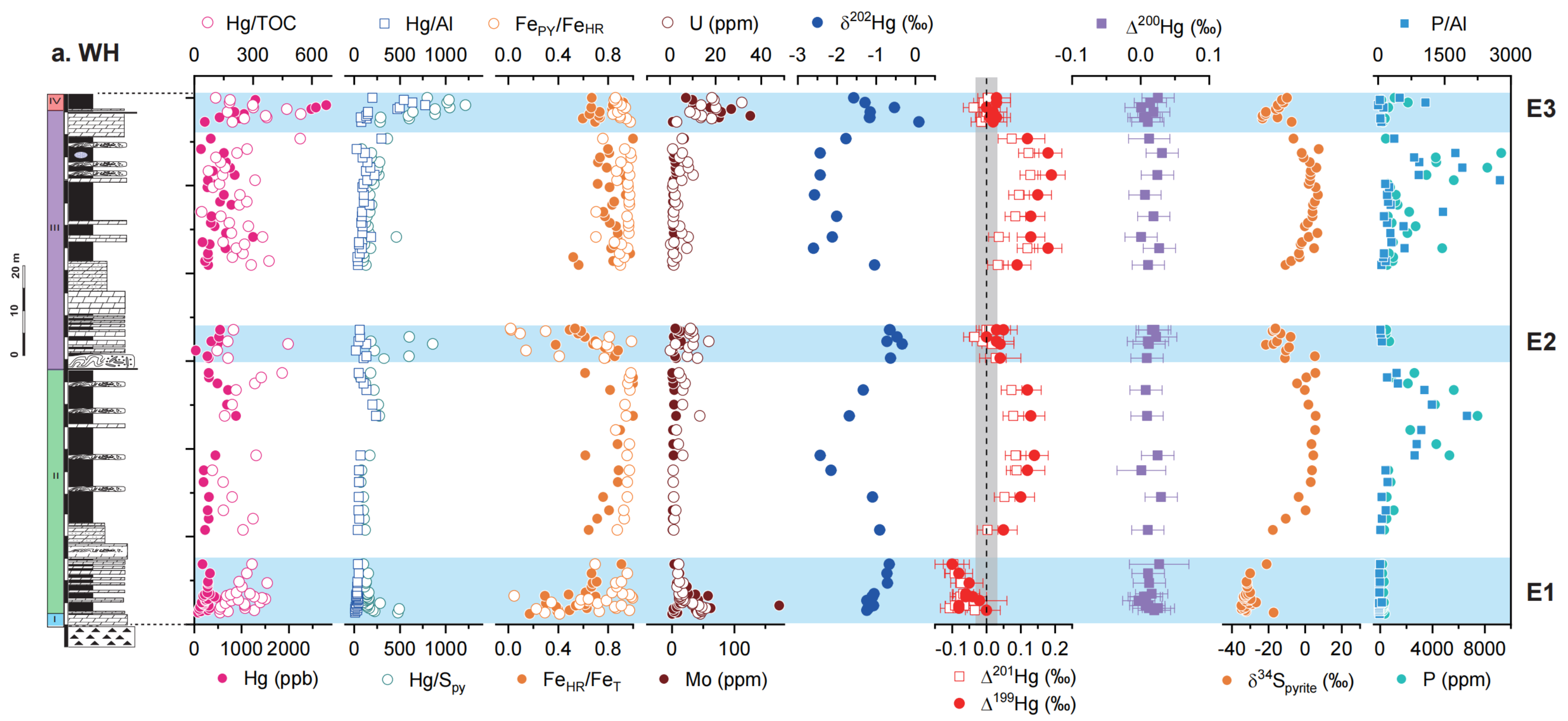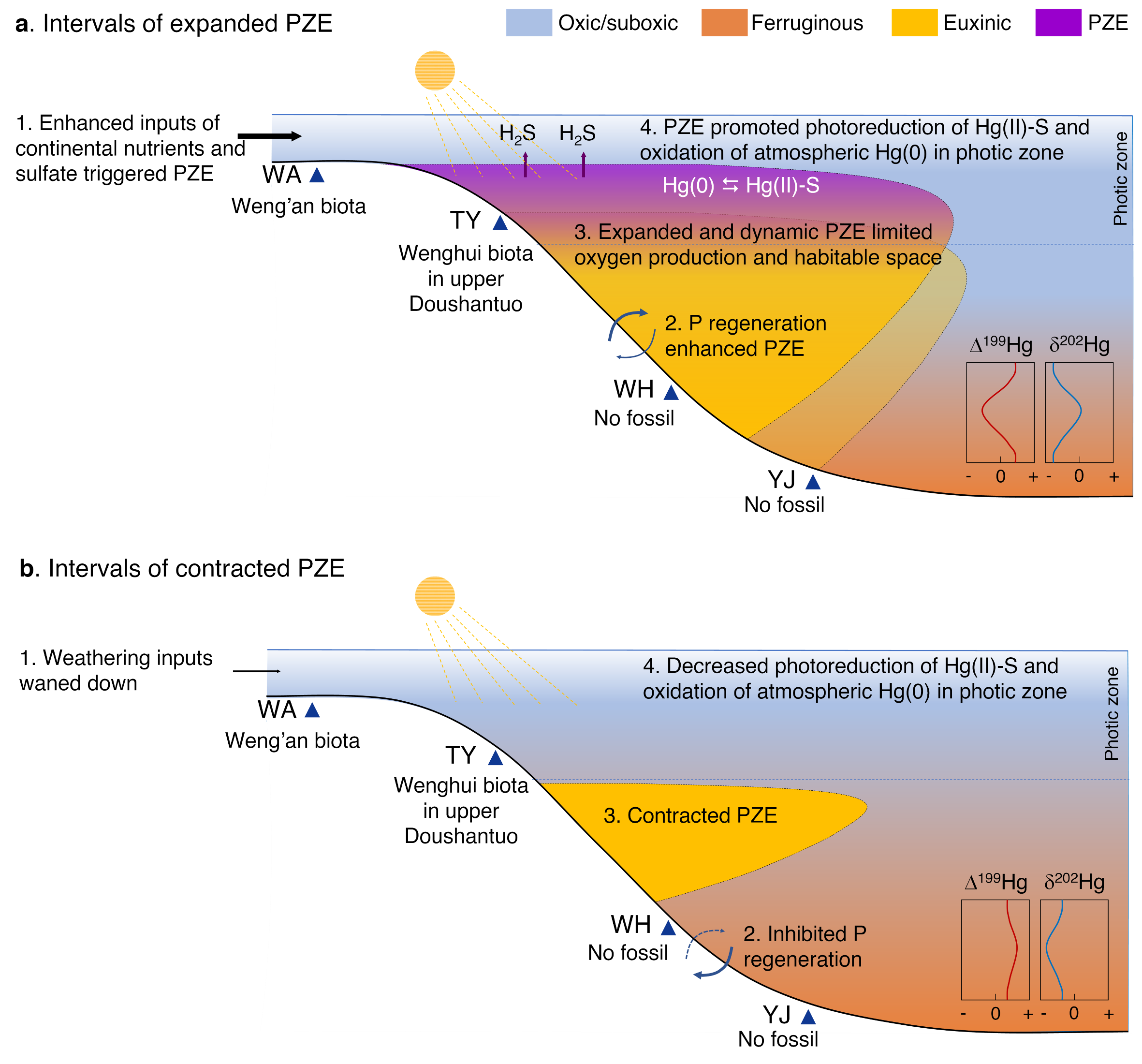Repeated hydrogen sulfide poisoning in the photic zone of the Ediacaran ocean
Published in Earth & Environment

The Ediacaran (635 to 539 million years ago) was a pivotal time period in Earth’s history, marked by the diversification of macroscopic multicellular eukaryotes (i.e., the “Ediacara biota”). Numerous studies have linked the rise of the Ediacara biota to ocean oxygenation. A relatively large body of geochemical datasets seem to suggest that there were transient (lasting up to a few million years) ocean oxygenation events even at the early stage of the Ediacaran, long before the rise of the Ediacara biota. However, some new studies cast doubts on the Ediacaran “oxygenation hypothesis”: was the rise of marine O2 level really as dramatical as previously thought? If not, what hampered the rise of marine O2 level? How to reconcile the much earlier ocean oxygenation and the delayed rise of the Ediacara biota?
A recent study published in Nature Communications may help resolve some of these questions. Based on a new proxy – mercury (Hg) isotope compositions from multiple black shale sections of the Ediacaran Doushantuo Formation – this study reports the first evidence for repeated and widespread enrichment of hydrogen sulfide (H2S) in the marine photic zone on the continental margin of South China Basin, where some of the most well-known assemblages of the Ediacara biota (e.g., the Weng'an and Wenghui biota) were found.
Mercury isotopes reveal the enrichment of H2S in the Ediacaran marine photic zone
The enrichment of H2S in the marine photic zone, a condition typically referred to as photic zone euxinia (PZE), is particularly detrimental to shallow marine inhabitants because the photic zone supports marine primary productivity and hosted the majority of early animals. Thus, PZE is typically considered as a potent kill mechanism for almost all Phanerozoic mass extinction events as well as a key factor responsible for the evolutionary stasis during the mid-Proterozoic. Mercury isotopes have emerged as a new indicator for PZE because Hg is highly sensitive to the photochemical and redox processes at the air-water interface, making them uniquely advantageous for recording the redox state of the marine photic zone. The indicative role of Hg isotopes for PZE was first proposed based on the discovery that black shales deposited under PZE conditions during the Mesoproterozoic Era and Late Devonian mass extinction exhibited significant negative shifts in mass-independent fractionation (MIF) and synchronous positive shifts in mass-dependent fractionation (MDF) of Hg isotopes, consistent with changes in traditional biomarker-based indicators of PZE (Zheng et al., 2018, 2023). These findings laid the foundation for the application of Hg isotopes in reconstructing PZE of the Ediacaran ocean. By analyzing Hg isotopes in four sections of the Doushantuo Formation and modeling Hg isotope shifts caused by various mechanisms (e.g., volcanism, terrestrial inputs and PZE), we identified three episodes of PZE that occurred periodically throughout the Ediacaran Period.

Why did photic zone H2S enrichment occur?
The development of PZE requires anoxic water column and the increased availability of marine sulfate for microbial sulfate reduction (i.e., the production of sulfide), both of which could be the consequence of enhanced continental weathering. The first episode of Ediacaran PZE was found in the aftermath of the Neoproterozoic Snowball Earth. During the process of deglaciation, a surge of nutrients (as well as sulfate) from freshly exposed land surfaces and finely ground glacial tills was delivered to the ocean, which increased primary productivity and thus oxygen consumption by the re-mineralization of newly produced organic matter, creating the anoxic water column and sulfide needed to develop PZE. This process is similar to the expansion of oxygen minimum zone in continental margins of the modern ocean, where excessive nutrient inputs are sustained by human activity. Other mechanism, such as massive volcanic eruption, could also lead to enhanced continental weathering, potentially triggering the third episode of PZE.
How did photic zone H2S poisoning affect ocean oxygenation and the Ediacara biota?
Recurrent and widespread PZE may have exerted a negative impact on the marine O2 level and early animals by promoting anoxygenic photosynthesis and limiting the habitable space of early macroscopic eukaryotic life via H2S poisoning. Extant anoxygenic phototrophs are able to grow photosynthetically with H2S as well as Fe(II) and H2. The competition for light and nutrients between anoxygenic and oxygenic photosynthetic organisms has been proposed as a key mechanism responsible for the delayed oxygenation of Earth's atmosphere and sustaining the relatively low level of oxygen throughout the mid-Proterozoic. Thus PZE may have created favorable marine environment for the growth of anoxygenic photoautotrophs, which in turn could suppress the O2 production by oxygenic photoautotrophs. Recurrent PZE also caused repeated H2S poisoning in the photic zone, limiting the ecological expansion of macroscopic multicellular eukaryotes. Among the four study sections, in relatively shallow-water shelf and upper slope facies where PZE was absent or sporadic, eukaryotes were able to colonize the benthic realm, as represented by the Weng'an and Wenghui biota. In contrast, in the lower slope and basinal facies where PZE was more persisted, no benthic fossils have been reported. A limitation of our study is that we did not directly measure samples from fossiliferous intervals, which warrant further investigations.

In summary, our study suggests that the repeated H2S poisoning in the shallow habitable zone at continental margins of the Ediacaran ocean initiated a series of negative feedbacks that hampered oxygen production by promoting anoxygenic photosynthesis and limiting the habitable space for eukaryotes carrying out oxygenic photosynthesis. Therefore, PZE could be an underappreciated mechanism for the transient nature of ocean oxygenation during the Ediacaran Period and the delayed rise of the Ediacara biota.
Reference:
Sahoo S. K., Planavsky N. J., Jiang G., Kendall B., Owens J. D., Wang X., Shi X., Anbar A. D. and Lyons T. W. (2016) Oceanic oxygenation events in the anoxic Ediacaran ocean. Geobiology 14, 457–468.
Sahoo S. K., Planavsky N. J., Kendall B., Wang X., Shi X., Scott C., Anbar A. D., Lyons T. W. and Jiang G. (2012) Ocean oxygenation in the wake of the Marinoan glaciation. Nature 489, 546–549.
Zheng W., Gilleaudeau G. J., Algeo T. J., Zhao Y., Song Y., Zhang Y., Sahoo S. K., Anbar A. D., Carmichael S. K., Xie S., Liu C.-Q. and Chen J. (2023) Mercury isotope evidence for recurrent photic-zone euxinia triggered by enhanced terrestrial nutrient inputs during the Late Devonian mass extinction. Earth Planet. Sci. Lett. 613, 118175.
Zheng W., Gilleaudeau G. J., Kah L. C. and Anbar A. D. (2018) Mercury isotope signatures record photic zone euxinia in the Mesoproterozoic ocean. Proc. Natl. Acad. Sci. U. S. A. 115, 10594–10599.
Follow the Topic
-
Nature Communications

An open access, multidisciplinary journal dedicated to publishing high-quality research in all areas of the biological, health, physical, chemical and Earth sciences.
Related Collections
With Collections, you can get published faster and increase your visibility.
Women's Health
Publishing Model: Hybrid
Deadline: Ongoing
Advances in neurodegenerative diseases
Publishing Model: Hybrid
Deadline: Dec 24, 2025




Please sign in or register for FREE
If you are a registered user on Research Communities by Springer Nature, please sign in